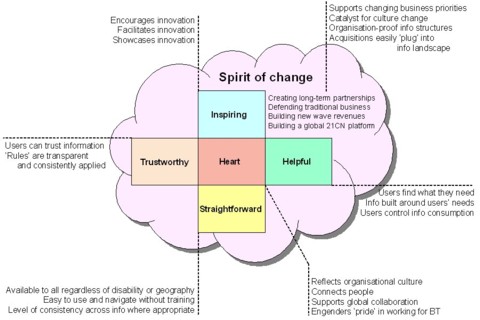I had an interesting meeting most of yesterday looking at the changing nature of content on the BT Intranet. The purpose of the meeting was to try to define a set of ‘user requirements’ for the:
- generation
- publication
- consumption
- management/governance
… of content on the BT Intranet given the increasing importance of collaborative/user generated content.
Some of the interesting things we discussed/decided were:
- ALL content is collaborative – what varies is the degree of collaboration involved in the four steps outlined above. So, even content that we had previously defined as ‘static’ (e.g. an HR policy document) will have involved collaboration in its generation and should have an element of collaboration during its consumption phase (i.e. users should be able to comment on it and/or rate its value in terms of meeting users’ needs). What’s interesting, is that the pre-publication collaboration used to be done off-line (in meetings or via e-mail) which is why it appeared ‘static’, but is now likely to be done on-line, for example, in shared workspaces in wikis, which now makes it appear to be ‘collaborative’ content.
- given the above, we decided that all content was part of a collaborative spectrum from 1 (simple commenting functionality) to 100 (fully crowd-sourced content) and that the user requirements change along that spectrum.
- we defined bands or types within that spectrum from ‘Formal’ at the top (1) down to ‘Crowd-sourced’ at the bottom (100) and attached characteristics and then functional requirements to those bands. It soon became clear that one could broadly categorise the top of the spectrum (1) as ‘information’ and the bottom (100) as ‘knowledge’.
- during the whole process we agreed not to mention ANY technology but remain completely technology agnostic … this was VERY hard!
Anyway … the upshot is that we have defined a set of content types, attached characteristics to those types, and then defined a set of functional requirements to each type. Finally, we created a list of requirements that were common along the whole spectrum (e.g. all should be searchable via a single BT search engine).
It was an interesting exercise and produced interesting outputs. Now all we have to do is hand them over to our technical colleagues and ask them how much it will cost to deliver against them all and how they intend to do it … 🙂
